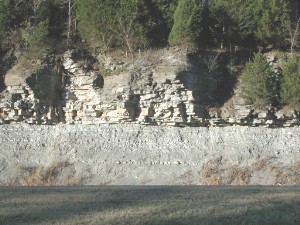Limestone
|
|
Limestone is a sedimentary rock composed of the mineral calcite (calcium carbonate). The primary source of this calcite is usually marine organisms. These organisms secrete shells that settle out of the water column and are deposited on ocean floors as pelagic ooze (see lysocline for information on calcite dissolution). Secondary calcite may also be deposited by supersaturated meteoric waters (groundwater that precipitates the material in caves). This produces speleothems such as stalagmites and stalactites. A further form is composed of oolites (Oolitic Limestone) and can be recognised by its granular appearance. Limestone makes up about 10 percent of the total volume of all sedimentary rocks.
Pure limestones are white or almost white. Because of impurities, such as clay, sand, organic remains, iron oxide and other materials, many limestones exhibit different colors, especially on weathered surfaces. Limestone may be crystalline, clastic, granular, or dense, depending on the method of formation. Crystals of calcite, quartz, dolomite or barite may line small cavities in the rock. Chert or Flint nodules are common in limestone layers. Bands of limestone emerge from the Earth's surface in often spectacular rocky outcrops and islands. Examples include the Verdon Gorge in France; Malham Cove in North Yorkshire, England; and the Ha Long Bay National Park in Vietnam.
Travertine is a banded, compact variety of limestone formed along streams, particularly where there are waterfalls and around hot or cold springs. Calcium carbonate is deposited where evaporation of the water leaves a solution that is supersaturated with chemical constituents of calcite. Tufa, a porous or cellular variety of travertine, is found near waterfalls.
Karst topography and caves are often formed in areas composed chiefly of limestone.
Limestone is a parent material of Mollisols.
Uses of limestone
Limestone is quarried for roadbeds, building and landscape construction, and cement manufacture.
Limestone is especially popular in architecture, and many landmarks around the world, especially in North America and Europe, are made primarily of the material. Limestone is readily available and relatively easy to cut into blocks or more elaborate carving. It is also long-lasting and stands up well to exposure. However, it is a very heavy material, making it impractical for tall buildings; it is also quite expensive. Limestone was most popular in the early 20th and late 19th centuries. Train stations, banks and other structures from that era are normally limestone. Limestone is used as a facade on some skyscrapers, but only in thin plates for covering rather than solid blocks. In North America, most limestone used in construction comes from Indiana.
Though the limestone used for construction is good for humid climates, it is vulnerable to acids, making acid rain a problem when it occurs in places where limestone is used extensively. The acids in the water can wear away the details of statues and other art.


